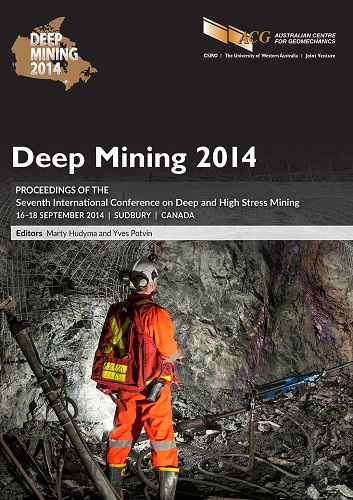Mine-scale numerical modelling, seismicity and stresses at Kiirunavaara Mine, Sweden

|
Authors: Vatcher, J; McKinnon, SD; Sjöberg, J |
DOI https://doi.org/10.36487/ACG_rep/1410_24_Vatcher
Cite As:
Vatcher, J, McKinnon, SD & Sjöberg, J 2014, 'Mine-scale numerical modelling, seismicity and stresses at Kiirunavaara Mine, Sweden', in M Hudyma & Y Potvin (eds), Deep Mining 2014: Proceedings of the Seventh International Conference on Deep and High Stress Mining, Australian Centre for Geomechanics, Perth, pp. 363-376, https://doi.org/10.36487/ACG_rep/1410_24_Vatcher
Abstract:
LKAB’s Kiirunavaara Mine, located in northern Sweden, has exhibited seismic behaviour since the mining production extended below 700 m depth. Iron ore is mined from the 4.5 km long orebody via sublevel caving at a production rate of 28 m t per annum. The deepest current production level is at approximately 800 m depth, and current mining plans call for mining to about 1,200 m depth. It is thus of critical importance for LKAB to gain a deeper understanding of the stress and rock mass behaviour at the mine. The Kiirunavaara orebody has complex geometry and geology, which is represented using the discontinuum distinct element code 3DEC. As part of a larger series of models investigating the influence of strength and structural geology on rock mass behaviour, the results of multiple continuum models are presented. The goals of these continuum models included: (i) obtain a better understanding of the virgin stress field and redistribution of stresses caused by mining, (ii) further define the extent of mining induced plastic failure; and (iii) increase the understanding of existing failure mechanisms at the mine. The elastic and plastic continuum models accurately produced principal stresses similar to measurements recently conducted at two sites in the mine, confirming the previously estimated virgin stress state. Spatial correlations between plastic failure in the model and seismicity in the hanging wall and footwall were found. However, these correlations were not consistent throughout either material for any evaluated set of material properties; either the plastic failure in the footwall or hanging wall corresponded well with seismicity. This may be because a set of rock mass properties which represent rock mass failure at this scale have not been evaluated or that some underlying failure mechanisms causing seismicity are not represented in the models, for example, failure along discontinuities. Some events larger than moment magnitude of 1.2 in the hanging wall, in particular shear source mechanisms events, do not correspond well with plastic failure from the model. These results potentially indicate that geological structures, which are not represented in these models, influence mine behaviour. The improved understanding of input data, rock mass behaviour, and failure mechanisms as a result of these models has a direct impact upon mine excavation design and future rock behaviour investigations, and will be used in the continued research, as well as in mine planning.
References:
Andrieux, PP, Hudyma, MR, O’Connor, CP, Li, H, Cotesta, L & Brummer, R 2008, ‘Calibration of large-scale three-dimensional
non-linear numerical models of underground mines using microseismic data’, Continuum and Distinct Element Numerical Modeling in Geo-Engineering, no. 07-04.
Ask, D 2013, Bergspänningsmätningar med Borre och spänningsmonitering med CSIRO HID i block 34, nivå KUJ1070, KUJ1165, och KUJ1252, Pöyry internal report (in Swedish), no. 8H50124.130 Pöyry, Vantaa.
Dahnér, C, Malmgren, L & Bošković, M 2012, ‘Transition from a non-seismic mine to a seismically active mine: Kiirunavaara Mine’, Proceedings of Rock Engineering and Technology for Sustainable Underground Construction: EUROCK 2012, International Society for Rock Mechanics, Lisboa.
Hanks, TC & Kanamori, H 1979, ‘A moment magnitude scale’, Journal of Geophysical Research, vol. 84, no. B5, pp. 2348-2350.
ISS International 2006, Glossary of terms used in routine mine seismology, internal report, no. REP-GLOS-001r0, ISS International, Sydney.
Itasca Consulting Group, Inc. 2013a, 3DEC: Three-Dimensional Distinct Element Code, version 5, Itasca Consulting Group, Inc. Minneapolis,
Sandström, D 2003, Analysis of the virgin state of stress at the Kiirunavaara mine, Licentiate thesis, no. 2003:02, Luleå University of Technology, Luleå.
Sjöberg, J, Perman, F, Quinteriro, C, Malmgren, L, Dahnér-Lindkvist, C & Boskovic, M 2012, ‘Numerical analysis of alternative mining sequences to minimise potential for fault slip rockbursting,’ Mining Technology, vol. 121, no. 4, pp. 226-235.
Skott, J 2013, Focal Mechanisms and Seismic Moment Tensors of Seismic Events in Kirunavaara Mine (Methodological- and Practical Aspects), master’s thesis, Luleå University of Technology, Luleå, no. 2013-75327629, viewed 7 April 2014, .
Vatcher, J, McKinnon, S & Sjöberg, J 2014, ‘Modelling methodology: structural geology and rock mass behaviour at Kiirunavaara Mine’, in R Alejano (ed.), Proceedings of Rock Engineering and Technology for Sustainable Underground Construction: EUROCK 2014, CRC Press, Boca Raton, pp. 643-648.
© Copyright 2025, Australian Centre for Geomechanics (ACG), The University of Western Australia. All rights reserved.
View copyright/legal information
Please direct any queries or error reports to repository-acg@uwa.edu.au
View copyright/legal information
Please direct any queries or error reports to repository-acg@uwa.edu.au